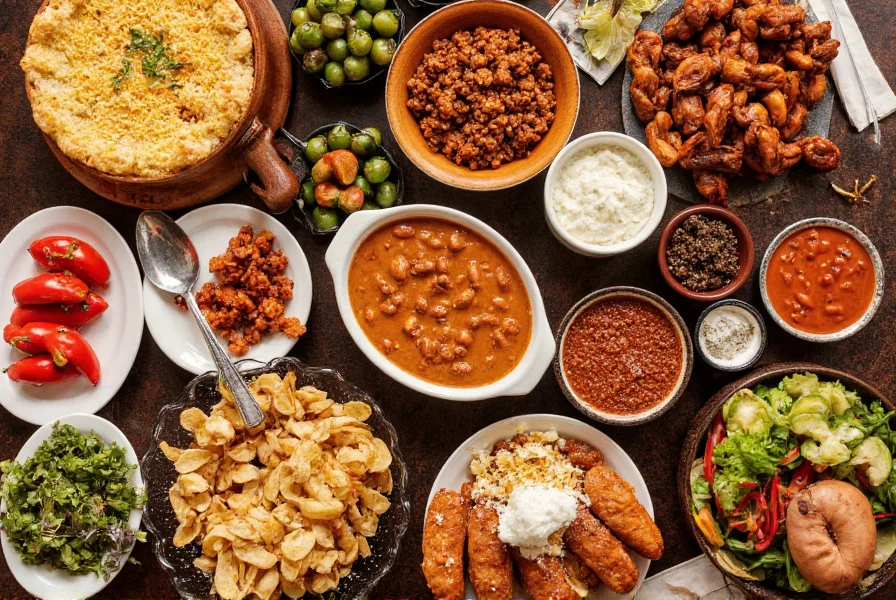When crafting the perfect chili meal, understanding flavor pairing principles transforms a simple bowl into a complete culinary experience. Chili's complex profile—featuring smoky, spicy, and savory notes—creates opportunities for strategic accompaniments that either contrast or complement its dominant characteristics. This guide explores scientifically backed pairings that satisfy both traditional expectations and innovative culinary approaches.
Classic Chili Accompaniments
Cornbread remains chili's most scientifically compatible partner due to its sweet corn flavor that counteracts capsaicin's heat while its crumbly texture provides textural contrast. The Maillard reaction products in properly baked cornbread create umami compounds that harmonize with chili's savory elements. For optimal results, serve cornbread slightly warm with butter to enhance mouthfeel.
Rice serves as both flavor neutralizer and volume extender, particularly effective with bean-heavy chili variations. Long-grain varieties like jasmine or basmati maintain structural integrity when mixed with chili, while their mild flavor allows spice profiles to shine. Nutritionally, rice provides complex carbohydrates that balance chili's protein density for more sustained energy release.
| Accompaniment | Flavor Function | Best Varieties |
|---|---|---|
| Cornbread | Heat neutralization | Skillet-baked, honey-sweetened |
| Rice | Texture contrast | Jasmine, Basmati, Brown |
| Shredded cheese | Spice mitigation | Cheddar, Monterey Jack, Queso Fresco |
Essential Toppings and Garnishes
Acidic elements like lime juice or pickled onions cut through chili's richness by stimulating saliva production, which naturally cools capsaicin's burn. Dairy toppings—sour cream, Greek yogurt, or shredded cheese—contain casein proteins that bind to capsaicin molecules, providing immediate heat relief. For optimal flavor layering, add dairy toppings just before serving to maintain temperature integrity.
Fresh herbs introduce volatile aromatic compounds that complement chili's earthy notes. Cilantro's aldehydes pair particularly well with cumin-forward recipes, while parsley offers a more neutral green note for tomato-based variations. Finely diced white onion provides enzymatic sharpness that balances richness without overwhelming other flavors.

Dietary-Specific Pairing Solutions
For gluten-free diets, cauliflower rice provides similar textural benefits to traditional rice while adding complementary nuttiness when roasted. The cruciferous vegetable's glucosinolates interact favorably with chili spices, creating new flavor dimensions through thermal decomposition during cooking.
Vegan pairings benefit from cashew-based 'sour cream' alternatives, which contain healthy fats that mimic dairy's heat-mitigating properties. Avocado slices introduce monounsaturated fats that bind capsaicin effectively while contributing buttery notes that enhance mouthfeel without animal products.
Beverage Pairing Science
Carbonated beverages like Mexican Coke work through dual mechanisms: the bubbles lift capsaicin from oral receptors while the sugar content provides immediate heat counteraction. For alcoholic options, medium-bodied beers with balanced bitterness (like Vienna lagers) cleanse the palate between bites without overwhelming chili's complexity.
Cold-brew coffee presents an unexpected but scientifically sound pairing—the beverage's natural chlorogenic acids interact with capsaicin to reduce perceived heat while its roasted notes complement smoky chili elements. Serve at 40°F (4°C) for optimal sensory experience.
Advanced Pairing Techniques
Professional chefs employ the 'flavor bridge' concept when designing chili menus—incorporating one shared ingredient across multiple components. For example, using the same smoked paprika in both chili and cornbread creates flavor continuity while maintaining textural contrast. This technique satisfies the brain's preference for familiar patterns while delivering novel sensory experiences.
Temperature contrast significantly enhances chili dining experiences. Serving chili at 165°F (74°C) alongside room-temperature toppings allows each component to maintain its optimal sensory properties. The thermal differential stimulates additional taste receptors, creating a more dynamic eating experience than uniformly hot presentations.

Practical Meal Planning Considerations
When planning chili-centered meals, consider the dish's glycemic load. High-protein, bean-based chili benefits from moderate carbohydrate accompaniments to balance macronutrients. For weeknight meals, prepare toppings in advance but assemble immediately before serving to maintain textural integrity—particularly important for脆 components like fried onions or tortilla strips.
Leftover chili transforms effectively when paired with new elements. Thursday's dinner chili becomes Friday's breakfast when topped with fried eggs and avocado, leveraging the Maillard reaction products from reheated chili to enhance egg flavors through synergistic umami interactions.
Frequently Asked Questions
What's the scientific reason cornbread pairs so well with chili?
Cornbread's alkaline pH counteracts chili's acidity, while its natural sugars bind with capsaicin to reduce perceived heat. The Maillard reaction products in properly baked cornbread create umami compounds that harmonize with chili's savory elements, creating a scientifically balanced flavor profile.
Which toppings effectively reduce chili's spiciness without altering flavor?
Full-fat dairy toppings like sour cream or shredded cheese contain casein proteins that bind to capsaicin molecules, providing immediate heat relief without masking flavor. Avocado's monounsaturated fats offer a vegan alternative that similarly binds capsaicin while adding complementary buttery notes.
How can I create balanced meals with chili for different dietary needs?
For gluten-free diets, use cauliflower rice or sweet potato cubes. Vegan meals benefit from cashew-based 'sour cream' and avocado. Low-carb options include zucchini noodles or roasted broccoli. Each variation maintains the critical flavor balance between chili's heat and cooling accompaniments while addressing specific nutritional requirements.
What beverages scientifically complement chili's flavor profile?
Carbonated beverages like Mexican Coke work through dual mechanisms: bubbles lift capsaicin from oral receptors while sugar counteracts heat. Medium-bodied beers with balanced bitterness cleanse the palate, and cold-brew coffee's chlorogenic acids interact with capsaicin to reduce perceived heat while complementing smoky notes.
Why does temperature matter when serving chili with accompaniments?
Serving chili at 165°F (74°C) alongside room-temperature toppings maintains each component's optimal sensory properties. This thermal differential stimulates additional taste receptors, creating a more dynamic eating experience than uniformly hot presentations, as different temperatures activate distinct flavor perception pathways.











 浙公网安备
33010002000092号
浙公网安备
33010002000092号 浙B2-20120091-4
浙B2-20120091-4